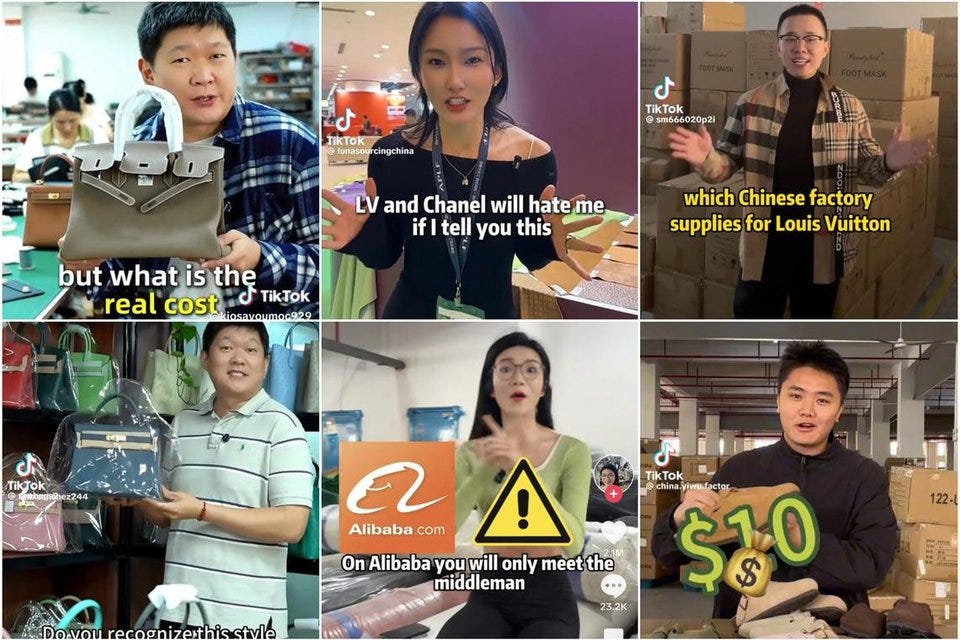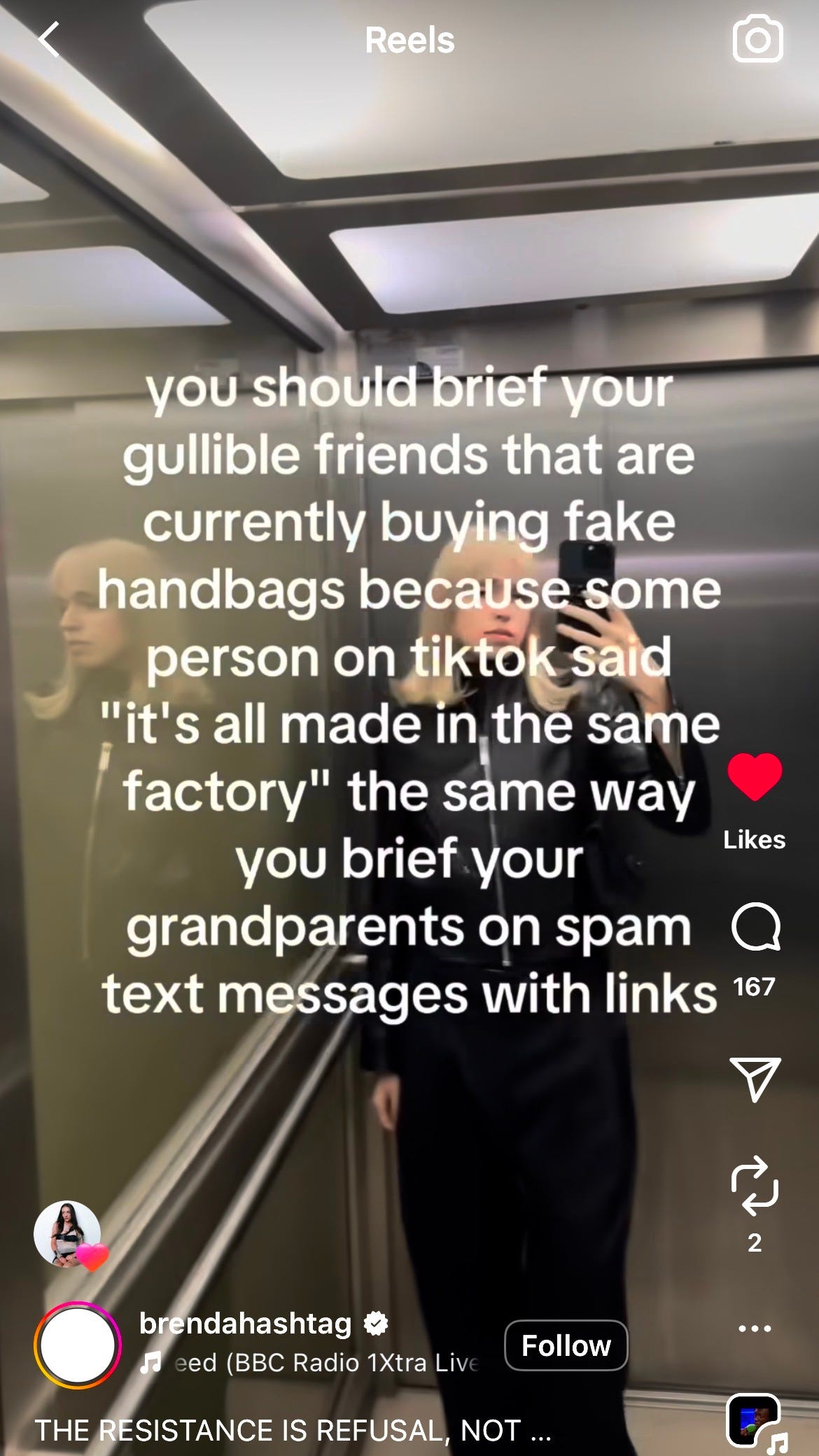What's up with those viral Chinese manufacturing videos?
How a wave of TikToks exposing luxury fashion might just be one big scam
In early April, a wave of viral TikToks from Chinese creators sent the fashion world (and Western luxury brands) into a full-blown tailspin.
The videos inundating my fyp all claimed to be spilling the tea about the world’s most coveted designer items.* Their message? Buy direct from us. We’re the real manufacturers behind all those products you wish you could afford, and we’ll sell you those clothes, shoes and accessories for cheap!
It was a captivating narrative, and I have to admit, for a moment, they got to me! Before I knew it, I was on DH Gate thinking I was getting the deal of the year. Then my critical thinking skills kicked in…
The backdrop to all of these videos is equally interesting. Escalating U.S.–China tensions, the international tariff war, and a generation of shoppers increasingly sceptical about the price of luxury have all created an online environment primed for these videos to go viral.
*I wanted to link the videos I saw, but they’ve been deleted from TikTok. RIP @senbags2, you were making some bold claims.
In this article, I’ll unpack:
What this viral trend is and what the creators are claiming;
Whether there’s any truth to it; and
Why it matters for fashion, consumers and the environment.
What’s the trend?
For about a week, TikTok was flooded with videos from Chinese creators who claimed to be filming their videos straight from the very factories that make luxury goods. These weren’t the usual dupe hauls where everyone is being careful not to claim authenticity.
In these videos, the creators were alleging that Chinese companies were the legitimate manufacturers of items for brands like Hermès, Birkenstock, Lululemon and Prada.
One video from @senbags2 was viewed millions of times before it was taken down. In this video, a man (presumably @senbags2) claimed that 80% of luxury bags are actually made in China and luxury houses just re-package them in Italy or France to get that ‘Made in Italy/France’ logo. In another video, he claimed that Hermès Birkin bags, which typically retail for over $ 30,000 USD and are marketed as handcrafted in France, were actually made in his factory for $1,400 USD.

Other videos followed a similar structure. Claiming that the clothes, shoes and bags we covet were made in their factories. And they were offering to sell those products to us directly.
These creators positioned themselves as whistleblowers. They laid out how cheap production costs really are, accused luxury brands of ripping consumers off and offered up direct-buy links for viewers to purchase “factory goods” for a steal.
But are these videos telling the truth?
In my opinion, probably not.
That’s not to say that no luxury is ever made in China (we’ll come back to that). But the bold claims being made in these videos don’t stand up to scrutiny.
Firstly, no proof has been offered. These supposed manufacturers haven’t shown contracts, emails, shipping documents, or anything else that would verify they actually work with the brands they’re naming. If they’ve already broken an NDA by posting a video, why not go the whole way and show receipts?
The reality is that international luxury brands have incredibly strict controls around their supply chains.
Hermès in particular is famous for the craftsmanship behind its Birkin bags. Each Birkin is handmade by a single artisan, takes over 18 hours to make, and is traceable through a unique code detailing the maker, workshop, and year of production. That’s not the kind of supply chain you can fake your way into on TikTok.
Secondly, the legal and reputational risk for any real supplier who went rogue like this would be enormous. If a manufacturer actually leaked their role in producing for a luxury brand, they’d almost certainly lose the contract, and possibly face legal action.
In today’s economic climate, it just doesn’t make sense to jeopardise a long-term, high-volume relationship with a global luxury brand in exchange for a handful of TikTok sales.
So why do people believe it?
Luxury brands have built their reputations, and their sky-high price tags, on the promise of exceptional craftsmanship. This promise is often conveyed through labels like “Made in France” or “Made in Italy.”
These “Made in …” labels are legally protected under EU law and are meant to guarantee that the product was either made or substantially transformed in the named country.
But in practice, the system isn’t watertight. While there are inspection bodies and regulations in place, loopholes exist and many brands quietly take advantage of them. It’s an open secret in the industry that a product only needs part of its production, often just the finishing touches, to take place in Italy or France to earn the prestigious label. Because in reality, brands rely on complex and globalised supply chains to make their products.
A significant portion of global manufacturing, including luxury goods, does happen in China. As Dana Thomas wrote in her Substack ‘The Style Files’ last week:
For at least twenty years, major European luxury brands have been sending their artisans from France and Italy to China to teach local workers how to make their products at the same quality level, and now the factories have those systems and techniques down pat. Plus, these factories have access to many of the same suppliers for leather, hardware, materials as the luxury brands do. In fact, the suppliers are often in China.
So, are these TikTok claims true? Probably not. But they’re easy to believe because there’s a kernel of truth in them, and the industry’s opacity is what gives these stories legs.
What are the implications?
This trend has hit the luxury sector at a vulnerable moment.
After years of price hikes and complaints of declining quality, consumers are already questioning whether luxury brands are still worth it. Add in a shaky global economy and scandals like the one that linked major European brands to sweatshops in Milan: you have a perfect storm.
Now, these viral videos are cracking open a bigger conversation about value, authenticity and how people perceive fashion.
Even if the videos aren’t true, the story they’re telling, that you’re being duped by designer brands, feels true to a lot of people. And in fashion, perception is everything.
What about sustainability?
While these videos position themselves as anti-corporate and empowering consumers, they’re still encouraging overconsumption. Dupes, even high-quality ones, feed the same fast-fashion mindset: more, faster, cheaper.
I get it, I clicked on the links too! There’s a thrill in the idea that you could beat the system. That maybe you’ve found a secret way to source a legitimate Birkin bag for a couple hundred dollars.
But here’s the hard truth: Any product being sold for way below market rate should raise a red flag. Even with the markups in luxury fashion, there is still a base level of quality and skill that you’re paying for.
High-quality materials, skilled labour, ethical working conditions and durable construction all cost money. If something is being sold for a fraction of the typical price, chances are it's cutting corners somewhere — whether that's in material quality, craftsmanship, labour practices or all of the above.
It’s up to you to decide: are the others overpriced, or is this product cheap for a reason?
So, does Made in China = bad? And Made in Europe = good?
Absolutely not. And let me say that again in bold: No!
“Made in China” has become cultural shorthand for cheap, low-quality or unethical. But that assumption is lazy at best, and misleading at worst. China is home to a vast and diverse manufacturing landscape. Yes, there are sweatshops and exploitative practices, but there are also factories with world-class standards, cutting-edge technology and skilled artisans.
Tanner Leatherstein is a leather expert who uses his social media to educate people about leather goods. He’s made several videos stating that you can find incredible craftsmanship, high-grade leather and precision work coming out of Chinese workshops. These products are often at a fraction of the cost, not because of lower quality, but because the brand hasn’t built in a 20x markup.
Meanwhile, “Made in Italy” or “Made in France” doesn’t automatically guarantee ethics or excellence. There have been well-documented cases of sweatshops allegedly operating within Europe. Exploitative labour conditions are not unique to countries like China or Bangladesh. Labour exploitation also exists in places like Prato, Italy, where workers allegedly made garments for luxury labels under “inhumane” conditions.
That’s because geography alone doesn’t guarantee ethics or quality — brands do.
Final thoughts
This TikTok trend isn’t just about dupes or tariffs or supply chains. It’s about trust. It’s about who we believe and what we value.
Even if these videos don’t reveal a literal conspiracy, they reveal something deeper: Consumers are suspicious of luxury brands, of fashion’s markup logic, and are unwilling to invest in an original product when cheaper alternatives exist.
And maybe that’s the real story here. Not that the bags are fake, but that our confidence in the entire industry is cracking — one TikTok at a time.









Fascinating